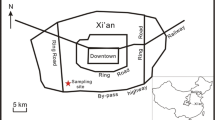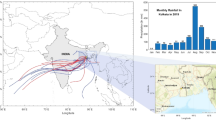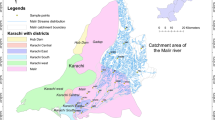Abstract
Pollutants emitted into the air not only have local effect but can also affect areas further from the source. The goal of this study was to assess a method for identifying the sources of element pollution in rainwater using enrichment factors supported by Weather Research and Forecasting (WRF) model. In this study, we collected nineteen rainwater samples at the two locations of Durham and Chimney Ridge in North Carolina, USA in July of 2014. The samples were analyzed for pH, conductivity and levels of major ions and a range of trace elements. These data showed that the pH of precipitation ranged between 3.91 and 6.65, with an average value of 4.98. The average electrical conductivity was 15.58 and 17.7 μS/cm for rainwater collected at Durham and Chimney Ridge, respectively. The lowest concentration of the elements analyzed was for thorium (Th) with an average concentration of 0.002 ppb, whereas the highest elemental concentration was for calcium (Ca) with an average concentration of 980.3 ppb. Enrichment factors for trace elements were assessed within three different groups as: (1) rarely enriched, (2) significantly enriched, and (3) highly enriched. Copper (Cu), zinc (Zn), arsenic (As), molybdenum (Mo), silver (Ag), cadmium (Cd), and lead (Pb) were highly enriched trace elements. The wind fields acquired by the WRF model indicated the probable contamination sources. Source identification indicated that the highest contribution of elements to precipitation was from industry. The results showed that the combined use of enrichment factors and the WRF model can be used to identify the sources of pollutants in precipitation samples.



Similar content being viewed by others
References
Aksu A (2015) Sources of metal pollution in the urban atmosphere (A case study: Tuzla, Istanbul). J Environ Heal Sci Eng 13:79. https://doi.org/10.1186/s40201-015-0224-9
Al-Momani I (2003) Trace elements in atmospheric precipitation at Northern Jordan measured by ICP-MS: acidity and possible sources. Atmos Environ 37:4507–4515. https://doi.org/10.1016/S1352-2310(03)00562-4
Amorello D, Orecchio S (2015) Vanadium and molybdenum concentrations in particulate from Palermo (Italy): analytical methods using voltammetry. Front Environ Sci Eng 9:605–614. https://doi.org/10.1007/s11783-014-0703-8
Anil I, Alagha O, Blaisi NI et al (2019) Source identification of episodic rain pollutants by new approach: combining satellite observations and backward air mass trajectories. Aerosol Air Qual Res 9:2827–2843. https://doi.org/10.4209/aaqr.2019.04.0187
Báez A, Belmont R, García R et al (2007) Chemical composition of rainwater collected at a southwest site of Mexico City, Mexico. Atmos Res 86:61–75. https://doi.org/10.1016/j.atmosres.2007.03.005
Başak B, Alagha O (2010) Trace metals solubility in rainwater: evaluation of rainwater quality at a watershed area, Istanbul. Environ Monit Assess 167:493–503. https://doi.org/10.1007/s10661-009-1066-7
Berlinger B, Weinbruch S, Ellingsen DG et al (2019) On the bio-accessibility of 14 elements in welding fumes. Environ Sci Process Impacts 21:497–505. https://doi.org/10.1039/C8EM00425K
Bi C, Chen Y, Zhao Z et al (2020) Characteristics, sources and health risks of toxic species (PCDD/Fs, PAHs and heavy metals) in PM25 during fall and winter in an industrial area. Chemosphere 238:124620. https://doi.org/10.1016/j.chemosphere.2019.124620
Brooks Avery G, Willey JD, Kieber RJ (2001) Diurnal variations in major rainwater components at a coastal site in North Carolina. Atmos Environ 35:3927–3933. https://doi.org/10.1016/S1352-2310(01)00202-3
Chate DM, Rao PSP, Naik MS et al (2003) Scavenging of aerosols and their chemical species by rain. Atmos Environ 37:2477–2484. https://doi.org/10.1016/S1352-2310(03)00162-6
Chen F, Dudhia J (2001) Coupling an advanced land surface–hydrology model with the Penn State–NCAR MM5 modeling system. Part I: Model implementation and sensitivity. Mon Weather Rev 129:569–585. https://doi.org/10.1175/1520-0493(2001)129%3c0569:CAALSH%3e2.0.CO;2
Deng WJ, Louie PKK, Liu WK et al (2006) Atmospheric levels and cytotoxicity of PAHs and heavy metals in TSP and PM2.5 at an electronic waste recycling site in southeast China. Atmos Environ 40:6945–6955. https://doi.org/10.1016/j.atmosenv.2006.06.032
Đorđević D, Mihajlidi-Zelić A, Relić D (2005) Differentiation of the contribution of local resuspension from that of regional and remote sources on trace elements content in the atmospheric aerosol in the Mediterranean area. Atmos Environ 39:6271–6281. https://doi.org/10.1016/j.atmosenv.2005.07.006
Dudhia J (1989) Numerical study of convection observed during the winter monsoon experiment using a mesoscale two-dimensional model. J Atmos Sci 46:3077–3107. https://doi.org/10.1175/1520-0469(1989)046%3c3077:NSOCOD%3e2.0.CO;2
Hasan NY, Driejana D, Sulaeman A (2017) Composition of ions and trace metals in rainwater in Bandung City Indonesia. J Proc Ser. https://doi.org/10.12962/j23546026.y2017i6.3310
Hopke PK, Jaffe DA (2020) Letter to the editor: Ending the use of obsolete data analysis methods. Aerosol Air Qual Res 20:688–689. https://doi.org/10.4209/aaqr.2020.01.0001
Huang X, Olmez I, Aras NK, Gordon GE (1994) Emissions of trace elements from motor vehicles: potential marker elements and source composition profile. Atmos Environ 28:1385–1391. https://doi.org/10.1016/1352-2310(94)90201-1
Kain JS (2004) The Kain-Fritsch convective parameterization: an update. J Appl Meteorol 43:170–181. https://doi.org/10.1175/1520-0450(2004)043%3c0170:TKCPAU%3e2.0.CO;2
Keeler GJ, Landis MS, Norris GA et al (2006) Sources of mercury wet deposition in eastern Ohio, USA. Environ Sci Technol 40:5874–5881. https://doi.org/10.1021/es060377q
Keresztesi Á, Nita I-A, Boga R et al (2020) Spatial and long-term analysis of rainwater chemistry over the conterminous United States. Environ Res 188:109872. https://doi.org/10.1016/j.envres.2020.109872
Lee DS, Garland JA, Fox AA (1994) Atmospheric concentrations of trace elements in urban areas of the United Kingdom. Atmos Environ 28:2691–2713. https://doi.org/10.1016/1352-2310(94)90442-1
Liu A, Mummullage S, Ma Y et al (2018) Linking source characterisation and human health risk assessment of metals to rainfall characteristics. Environ Pollut 238:866–873. https://doi.org/10.1016/j.envpol.2018.03.077
Liyandeniya AB, Deeyamulla MP, Priyantha N (2020) Source apportionment of rainwater chemical composition in wet precipitation at Kelaniya in Sri Lanka. Air Qual Atmos Heal. https://doi.org/10.1007/s11869-020-00903-w
Mason B, Moore CB (1982) Principles of Geochemistry, 4th Edtion. Wiley, Hoboken
Migliavacca D, Teixeira E, Wiegand F et al (2005) Atmospheric precipitation and chemical composition of an urban site, Guaíba hydrographic basin, Brazil. Atmos Environ 39:1829–1844. https://doi.org/10.1016/j.atmosenv.2004.12.005
Mlawer EJ, Taubman SJ, Brown PD et al (1997) Radiative transfer for inhomogeneous atmospheres: RRTM, a validated correlated-k model for the longwave. J Geophys Res Atmos 102:16663–16682. https://doi.org/10.1029/97JD00237
Mugica V, Maubert M, Torres M et al (2002) Temporal and spatial variations of metal content in TSP and PM10 in Mexico City during 1996–1998. J Aerosol Sci 33:91–102. https://doi.org/10.1016/S0021-8502(01)00151-3
Nriagu JO, Pacyna JM (1988) Quantitative assessment of worldwide contamination of air, water and soils by trace metals. Nature 333:134–139. https://doi.org/10.1038/333134a0
Nuhoglu Y, Yazıcı M, Nuhoglu C et al (2020) Distribution of trace metals in street dusts and tree leaves and their source identification in a mid-populated Anatolian city. Bull Environ Contam Toxicol 105:103–110. https://doi.org/10.1007/s00128-020-02882-1
Querol X, Zhuang X, Alastuey A et al (2006) Speciation and sources of atmospheric aerosols in a highly industrialised emerging mega-city in Central China. J Environ Monit 8:1049–1059. https://doi.org/10.1039/B608768J
Samayamanthula DR, Sabarathinam C, Alayyadhi NA (2021) Trace elements and their variation with pH in rain water in arid environment. Arch Environ Contam Toxicol 80:331–349. https://doi.org/10.1007/s00244-020-00787-y
Santos PSM, Otero M, Santos EBH, Duarte AC (2011) Chemical composition of rainwater at a coastal town on the southwest of Europe: What changes in 20 years? Sci Total Environ 409:3548–3553. https://doi.org/10.1016/j.scitotenv.2011.05.031
Song F, Gao Y (2009) Chemical characteristics of precipitation at metropolitan Newark in the US East Coast. Atmos Environ 43:4903–4913. https://doi.org/10.1016/j.atmosenv.2009.07.024
Soriano A, Pallarés S, Pardo F et al (2012) Deposition of heavy metals from particulate settleable matter in soils of an industrialised area. J Geochemical Explor 113:36–44. https://doi.org/10.1016/j.gexplo.2011.03.006
Thurston GD, Spengler JD (1985) A quantitative assessment of source contributions to inhalable particulate matter pollution in metropolitan Boston. Atmos Environ 19:9–25. https://doi.org/10.1016/0004-6981(85)90132-5
Tian HZ, Wang Y, Xue ZG et al (2010) Trend and characteristics of atmospheric emissions of Hg, As, and Se from coal combustion in China, 1980–2007. Atmos Chem Phys 10:11905–11919. https://doi.org/10.5194/acp-10-11905-2010
Tubek S, Bunio A, Szyguła R, Tubek A (2010) Frequency of hospitalization for angina pectoris, stroke, and peripheral venous thrombosis and its relationship to elements in rainwater in Opole Voivodship, Poland, During 2000–2002. Biol Trace Elem Res 133:243–250. https://doi.org/10.1007/s12011-009-8434-6
**a L, Gao Y (2011) Characterization of trace elements in PM2.5 aerosols in the vicinity of highways in northeast New Jersey in the U.S. east coast. Atmos Pollut Res 2:34–44. https://doi.org/10.5094/APR.2011.005
**ao J (2016) Chemical composition and source identification of rainwater constituents at an urban site in **’an. Environ Earth Sci 75:209. https://doi.org/10.1007/s12665-015-4997-z
Yongming H, Peixuan D, Junji C, Posmentier E (2006) Multivariate analysis of heavy metal contamination in urban dusts of **’an, Central China. Sci Total Environ 355:176–186. https://doi.org/10.1016/j.scitotenv.2005.02.026
Zhang Y, Wang X, Chen H et al (2009) Source apportionment of lead-containing aerosol particles in Shanghai using single particle mass spectrometry. Chemosphere 74:501–507. https://doi.org/10.1016/j.chemosphere.2008.10.004
Zhao M, Li L, Liu Z et al (2013) Chemical composition and sources of rainwater collected at a semi-rural site in Ya’an, southwestern China. Atmos Clim Sci 03:486–496. https://doi.org/10.4236/acs.2013.34051
Acknowledgements
We would like to thank Dr. Mark Wiesner, professor of Civil and Environmental Engineering at Duke University, for his support and allowing his laboratory to be used for this study.
Author information
Authors and Affiliations
Corresponding author
Ethics declarations
Conflict of interest
The authors declare no conflict of interest.
Supplementary Information
Below is the link to the electronic supplementary material.
Rights and permissions
About this article
Cite this article
Yavuz, E., Kuzu, S.L., Kanat, G. et al. Investigating the Combined Use of Enrichment Factor and Weather Research and Forecasting (WRF) Modelling for Precipitation Sample Source Identification: A Case Study in North Carolina, USA. Arch Environ Contam Toxicol 81, 182–188 (2021). https://doi.org/10.1007/s00244-021-00843-1
Received:
Accepted:
Published:
Issue Date:
DOI: https://doi.org/10.1007/s00244-021-00843-1




